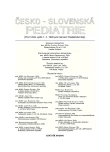-
Medical journals
- Career
Contribution of Static Renal Scintigraphy Using Pinhole Collimator in Childhood
Authors: D. Chroustová; M. Kolská; I. Urbanová; M. Klánová
Authors‘ workplace: Klinika dětí a dorostu FN Královské Vinohrady, Praha přednosta prof. MUDr. J. Lebl, CSc. ; Dětské oddělení FN Bulovka, Praha primář MUDr. M. Fuks ; Klinika nukleární medicíny FN Královské Vinohrady, Praha přednosta MUDr. O. Lang
Published in: Čes-slov Pediat 2005; 60 (10): 551-557.
Category: Original Papers
Overview
Renal scintigraphy using 99mTc DMSA (dimercaptosuccinic acid) is considered to be “the gold standard” in the diagnosis of acute pyelonephritis and it is a widely used method for detecting parenchymal changes. The first-rate imaging of kidneys is very important especially in pediatric diagnosis. The aim of this study was a correlation of renal images of the routine planar scintigraphy using HR (high resolution) collimator with parallel holes and pinhole collimator in detection of parenchymal changes in children.
Patients and methods:
94 children (47 girls and 47 boys) aged 2 months – 5 years were examined. The examinations were repeated in 22 children and 122 examinations were performed altogether. Static renal scintigraphy using HR collimator with parallel holes was done on planar Gamma camera MB 9200 (Gamma Budapest) with the patient in a supine position in 4 projections.
Data of computer assisted collection were 200 000 counts/image, matrix 128 x 128, zoom 3–4. Static renal scintigraphy using pinhole collimator (size of hole was 2 mm) of each kidney was performed on planar Gamma camera in supine and lateral positions. Data of computer assisted collection were 300 sec/image, matrix 128 x 128, zoom 1.Results:
In total the number of all examinations there were 49 accordingly positive findings and 59 accordingly negative findings. The different findings in number of renal reductions or defects were found in 14 cases.Conclusion:
According to author’s experience static renal scintigraphy using pinhole collimator gives detailed image of kidneys. In group of 14 children with different findings in number of renal reductions or defects kidneys with more defects were found. There was no solitary renal defect seen only on the image using pinhole collimator, which would lead to a change of the diagnosis.
Only single images using pinhole collimator by static renal scintigraphy aren’t sufficient; they don’t consider the accumulative capability of kidneys including mathematic analysis of global and separate renal function. Static renal scintigraphy supplemented by pinhole collimator images becomes a more precise examination, which can better consider the number and extent of renal parenchymal changes.Key words:
planar renal scintigraphy using 99mTc DMSA, HR collimator, pinhole collimator, childhood
Labels
Neonatology Paediatrics General practitioner for children and adolescents
Article was published inCzech-Slovak Pediatrics

2005 Issue 10
Most read in this issue- Alpha-1-antitrypsin Deficiency
- Schonlein-Henoch Nephritis – Peculiarities of Clinical Course
- Contribution of Static Renal Scintigraphy Using Pinhole Collimator in Childhood
Login#ADS_BOTTOM_SCRIPTS#Forgotten passwordEnter the email address that you registered with. We will send you instructions on how to set a new password.
- Career

